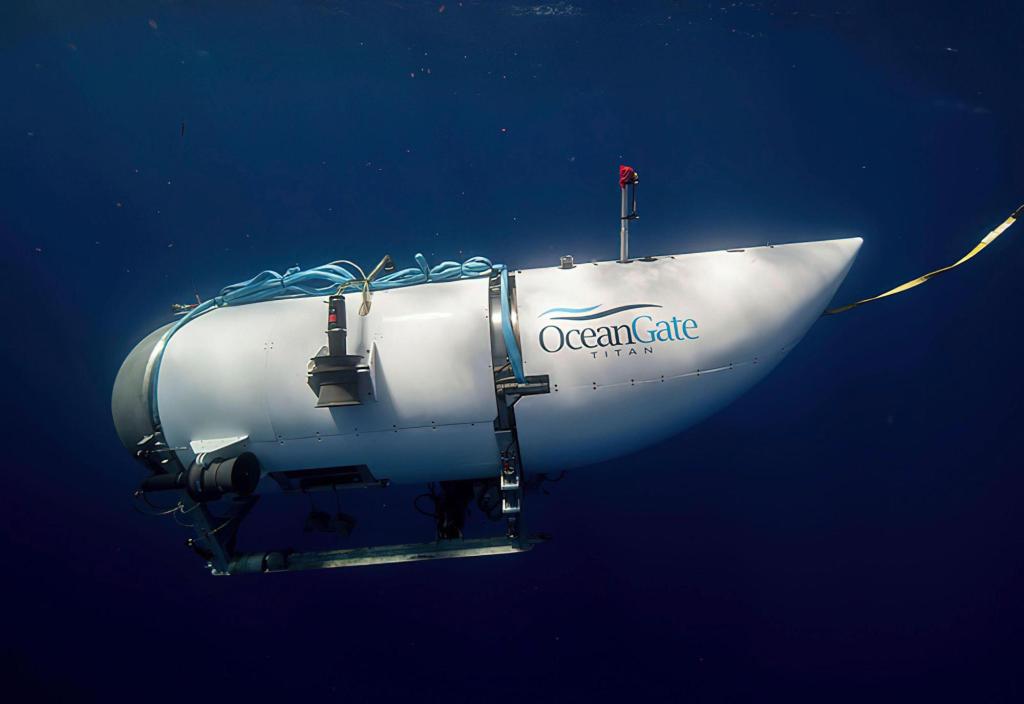
Live updates | 8-hour time delay to report missing Titan raises questions – The Denver Post
[ad_1]

By The Associated Press
Follow along for live updates on the submersible that vanished while taking five people down to the wreck of the Titanic.
___
8-HOUR TIME DELAY TO REPORT MISSING TITAN RAISES QUESTIONS
Questions remain about the eight hours between when the Titan lost communication with the surface and when its Canadian support vessel reported it missing to the U.S. Coast Guard.
The time delay has yet to be explained by the company that owns the submersible, OceanGate Expeditions.
Sean Leet, head of the company that co-owns the Titan’s support ship, has refused to discuss the timeline, saying only that “all protocols were followed for the mission.”
But experts familiar with deep-sea exploration say those lost hours raise red flags.
The submersible used a rudimentary system that basically communicated with the surface ship through text message, and likely lacked an emergency radio beacon that could have floated to the surface and started beeping if there was an emergency.
The vessel had lost communication with the support ship, Canadian research icebreaker Polar Prince, during previous dives.
___
What to know:
— What we know so far about the submersible, what may have gone wrong, and what’s being done to find it
— Debris has been found near the Titanic during search for submersible, US Coast Guard says
— Did initial delays in communication hamper tourist sub search?
— A look at the five passengers aboard the vessel
— A 2018 lawsuit warned that insufficient prototype testing could put passengers in danger
— The vessel is a submersible not a submarine, and there is a key difference
___
PAST DEEP-SEA RESCUES SHOW CHALLENGES FOR TITAN
The search for the Titan submersible has drawn attention to other deep-sea rescues, only some of which ended in lives being saved.
Those successful efforts — from a submersible off Ireland to a submarine off the New Hampshire coast — offer some measure of hope for the passengers and their families.
But many ended with some, if not all, the passengers on board dying — demonstrating the inherent risk of operating in the deep ocean.
Either way, those rescue missions were not as complex as the effort to find the Titan submersible. They were often in shallower waters and, in several cases, were much bigger crafts.
For example, the USS Squalus sank off the coast of New England in 1939 during a test dive, due to a catastrophic valve failure that partially flooded the military submarine. A newly developed rescue chamber was lowered into the water to famously save the surviving 33 crew members. Twenty-six others drowned in the initial accident.
But the Titan is a civilian vessel and would not have standard Navy hatches that could attach to a rescue chamber like the one used for the Squalus. That makes it almost impossible to rescue any of the submersible’s occupants if they are found underwater.
___
SEARCH FOR TITAN SHOWS NEED FOR MORE DEEP-SEA TECH
An underwater researcher says the search for the Titan shows the desperate need for more deep-sea technology in the U.S.
The unsuccessful efforts have “really opened up people’s eyes that we need a much more robust capability over larger areas of the ocean to be able to detect and sense where things are,” said Nick Rotker, who leads underwater research for non-profit research and development company MITRE.
The U.S. needs more underwater robots and remotely operated underwater vehicles, known as ROVs, to ensure safety, he said, especially as private exploration of the ocean expands.
“The issue is we don’t have a lot of capability or systems that can go to the depth this vessel was going to,” Rotker said.
Several ROVs are in the North Atlantic waters to search for the missing submersible. One found a debris field near the Titanic wreckage that could be linked to the Titan. The debris field was discovered by a robot from a Canadian vessel.
___
DEBRIS FIELD DISCOVERED BY DEEP-SEA ROBOT
Officials say a remote-operated robot discovered the debris field near the Titanic that could be linked to the missing Titan.
The robot is one of several remotely operated vehicles, known as ROVs, scanning the sea floor for clues of the missing submersible.
The ROVs are outfitted with cameras and travel to depths many other vessels cannot and have been used for undersea exploration for decades.
The Coast Guard’s post on Twitter gave no details, such as whether officials believe the debris field is connected to the Titan.
The Titanic wreckage is located at a depth of 12,500 feet (3.8 kilometers) in the North Atlantic waters.
The Coast Guard has scheduled an afternoon news conference in Boston to discuss the ROV’s findings.
___
DEBRIS FIELD FOUND NEAR TITANIC SITE AMID SEARCH FOR MISSING SUBMERSIBLE
The U.S. Coast Guard says an underwater vessel has located a debris field near the Titanic in the search for a missing submersible with five people aboard, a potential breakthrough in an increasingly urgent around-the-clock effort.
The Coast Guard’s post on Twitter gave no details, such as whether officials believe the debris is connected to the Titan, which was on an expedition to view the wreckage of the Titanic. The search passed the critical 96-hour mark Thursday morning when breathable air could have run out.
The Titan was estimated to have about a four-day supply of breathable air when it launched Sunday morning in the North Atlantic — but experts have emphasized that was an imprecise approximation to begin with and could be extended if passengers have taken measures to conserve breathable air.
____
PAKISTAN’S GOVERNMENT FOLLOWING DEVELOPMENTS IN SEARCH FOR TITAN
A spokesperson for Pakistan’s Foreign Ministry says the country’s diplomats in the United States and Canada are following developments in the search for the Titan.
Pakistani businessman Shahzada Dawood and his son, Suleman, are among the five people aboard the submersible that went missing Sunday as it descended to the wreckage of the Titanic.
“We have confidence that this matter will be pursued effectively by the local authorities,” ministry spokesperson Mumtaz Zahra Baloch said Thursday at a news conference in Islamabad.
It was the first comment by any Pakistani official since the submersible vanished.
“We would not like to speculate on the circumstances of this incident and we would also like to respect the wishes of the Dawood family that their privacy may be respected,” she said.
The Dawoods are members of one of the country’s most prominent families.
The family’s company, Dawood Hercules Corp., based in Karachi, is involved in agriculture, petrochemicals, telecommunication infrastructure and other ventures.
___
AS OXYGEN LEVELS RUN LOW ON BOARD TITAN, PASSENGERS CAN MAKE MINOR CONSERVATION EFFORTS
The Titan was said to have enough oxygen on board to to last 96 hours, according to the U.S. Coast Guard, meaning they could run out sometime Thursday.
But there are ways the five passengers can conserve, said professor professor Hugh Montgomery, director of the Centre for Human Health and Performance at University College London, even as temperatures drop to near freezing.
The human body makes every effort to maintain a core body temperature so shivering may increase oxygen demands, he said.
“The only effective way to limit O2 demand in this circumstance is not to burn excess energy,” Montgomery said.
That means staying immobile or sleeping. Meditation can also slightly reduce oxygen demand by producing less stress hormones, less movement and more relaxed muscles, but such effects will be marginal, he said.
___
FRENCH DEEP SEA ROBOT JOINS INTERNATIONAL SEARCH FOR MISSING SUBMERSIBLE
A French deep sea robot that can dive to depths of 6,000 meters (19,685 feet) has joined the search for the missing Titan submersible and its five passengers.
France’s state-run ocean research institute said Thursday the Victor 6000 is fitted with cameras, lights and robotic arms that could, if Titan is found, assist in raising it to the surface.
“With all of its cameras and things, we’re capable of finding things really well in an area 20 to 30 meters (yards) around,” said Olivier Lefort, the fleet director at the French ocean research institute Ifremer. He added that if the Titan is found, Victor 6000 could help attach cables to the submersible in an effort to raise it.
The robot was aboard the French ocean research ship L’Atalante, which was working in the Atlantic, 48 hours away, when the Titan vanished Sunday on its way to the Titanic wreckage, which is at about 3,800 meters (12,467 feet) deep.
___
‘DESPERATE SITUATION:’ SCIENTISTS, WHILE REALISTIC ABOUT SURVIVAL CHANCES, OFFER HOPE
Scientists, while remaining realistic about the chances of finding the Titan on the vast ocean floor, are still offering a glimmer of hope.
Rob Larter, a marine geophysicist with the British Antarctic Survey, said in London on Thursday that it’s incredibly difficult to find an object the size of the Titan in a totally dark environment. He says it’s not going to be found with active sonar from a surface ship, but rather with a towed or autonomous vehicle that’s near the seafloor. Even those vehicles can see just a matter of meters.
“I’ve been involved in searches for hydrothermal vent sites,” he said. “We’ve have the vehicles just a few tens of meters away and missed them and then come back and find them. So it really is, you know, literally it’s just a needle in a haystack situation unless you’ve got a pretty precise location”
Jamie Pringle, an expert in forensic geosciences at Keele University in the United Kingdom says the first 24 hours are critical in these kinds of rescue operations and that time period has long passed.
“So there’s always a chance. It’s never zero. But I think obviously the longer the time elapses, the lower the chance of success,” he said.
Larter called it a “desperate situation” buy says you try to stay optimistic as long as possible.
“It’s kind of unimaginable if people are alive, trapped in a submersible with oxygen supplies running down,” he said.
___
THE SEARCH FOR THE SUBMERSIBLE IS NEARING THE CRITICAL 96-HOUR MARK
The search is nearing the critical 96-hour mark when breathable air is expected to run out, reaching a vital moment in the intense effort to save the five people aboard.
The Titan submersible was estimated to have a 96-hour supply of breathable air when it launched Sunday morning in the North Atlantic. That means the deadline to find and rescue the sub is roughly between 6 a.m. (1000 GMT) and 8 a.m. (1200 GMT) on Thursday based on estimates the U.S. Coast Guard and company behind the expedition have provided.
Experts say that the oxygen supply number is an imprecise estimate and could be extended if passengers have taken measures to conserve breathable air. And it’s not known if they survived since the sub disappeared Sunday morning.
Officials have expanded the coverage area to thousands of miles — twice the size of Connecticut and in waters 2 1/2 miles deep. Airplanes, ships, remote-operated underwater vehicles and a U.S. Navy-owned specialized salvage system have been deployed, concentrating where unidentified noises had been heard for two days. The noises raised hopes of a possible discovery.
[ad_2]
Source link




